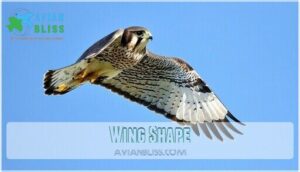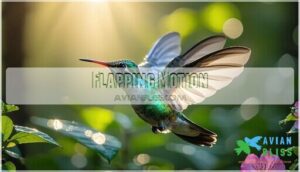This site is supported by our readers. We may earn a commission, at no cost to you, if you purchase through links.
 Most birds can’t fly straight up from the ground like nature’s helicopters, but some are true vertical takeoff champions.
Most birds can’t fly straight up from the ground like nature’s helicopters, but some are true vertical takeoff champions.
Hummingbirds master this trick with lightning-fast wing beats, while ducks and pigeons also pull off impressive straight-up launches.
You’ll find that most other birds need a running start or a leap from higher ground to get airborne.
The secret lies in wing shape and flapping power – some birds generate enough thrust to overcome gravity from a dead stop, while others rely on horizontal momentum.
It’s like the difference between a rocket launch and an airplane taking off from a runway.
The mechanics behind these different flight styles reveal nature’s clever engineering solutions.
Table Of Contents
- Key Takeaways
- Types of Birds That Can Fly Vertically
- Factors That Affect Vertical Takeoff in Birds
- Why Can’t All Birds Fly Straight Up?
- Different Flying Styles of Birds
- The Mechanics of Bird Flight
- The Impressive Flight of Peregrine Falcons and Pigeons
- The Role of Tail Feathers in Vertical Takeoff
- Frequently Asked Questions (FAQs)
- Why do birds fly straight up from the ground?
- Can birds fly straight up?
- Do birds fly vertically?
- How do birds leave the ground and fly?
- Can birds fly straight up like a helicopter?
- Do all birds fly the same way?
- Can birds fly directly up?
- What birds can fly straight up?
- Can birds fly upwards?
- What does it mean when birds fly in a straight line?
- Conclusion
Key Takeaways
- You’ll find that only a few bird species can actually launch straight up from the ground – hummingbirds, certain ducks, and pigeons have developed special wing structures and flight techniques that generate enough thrust to overcome gravity from a dead stop.
- You can see the secret lies in wing shape and flapping power – birds with high aspect ratio wings, lightweight bodies, and powerful chest muscles create maximum lift through rapid wingbeats of up to 80 times per second.
- You’ll notice most other birds can’t achieve vertical takeoff due to evolutionary tradeoffs – their wing muscles aren’t built for sustained vertical thrust, and their body weight requires too much energy expenditure to rocket straight up like nature’s helicopters.
- You can observe different takeoff strategies among bird species – while some master vertical flight through specialized anatomy, others rely on running starts, wind assistance, or jumping from elevated perches to get airborne efficiently.
Types of Birds That Can Fly Vertically
You’ll find that only a few bird species can actually launch straight up from the ground without a running start.
Hummingbirds, certain ducks, and pigeons have developed special wing structures and flight techniques that let them take off vertically when they need to escape danger or navigate tight spaces.
Hummingbirds
Regarding hummingbirds, you’re looking at nature’s tiny helicopters that can rocket straight up from any surface.
Their incredible wing structure beats up to 80 times per second, creating lift on both upward and downward strokes. This allows for perfect hummingbird hovering and instant vertical takeoff whenever they need to escape danger or reach nectar sources.
Their habitats range across the Americas, with Ecuador hosting diversity.
Here’s what makes their bird flight so remarkable:
- High metabolism rates fuel their rapid wing beats and energy-intensive hovering abilities
- Flexible wing joints rotate nearly 180 degrees, generating thrust in all directions
- Lightweight bodies combined with powerful flight muscles create an unmatched power-to-weight ratio
Ducks
Certain duck species have mastered the art of vertical takeoff through remarkable waterfowl flight techniques.
Dabbling ducks like mallards, pintails, and teals demonstrate impressive duck aerodynamics by slapping their wings rapidly against water surfaces while pushing with tail feathers.
This duck takeoff method generates tremendous thrust, allowing these bird species to launch straight upward at about 10 flaps per second.
Many waterbirds achieve this vertical take-off ability without needing a run-up.
Unlike diving ducks that need running starts, these masters of bird flight can escape predators instantly using their specialized takeoff techniques.
Pigeons
Pigeons burst into vertical takeoff with lightning speed, showcasing some of nature’s most impressive bird flight abilities.
You’ll notice these urban birds don’t need running starts like larger species. Their powerful pigeon flight muscles generate explosive thrust through aggressive wing beats, while their compact bodies make vertical ascension look effortless.
Key pigeon takeoff techniques include:
- Explosive leg push combined with rapid wing extension
- Synchronized pigeon flock dynamics during group launches
- Precise pigeon landing mechanics for controlled descents
- Urban pigeon flight adaptations for tight city spaces
Their takeoff speed rivals small aircraft, making them a notable example of nature’s impressive abilities, with powerful pigeon flight capabilities.
Factors That Affect Vertical Takeoff in Birds
You’ve probably wondered why your backyard robin can’t launch straight up like a helicopter, while hummingbirds seem to defy gravity with ease.
Several key factors determine whether a bird can pull off this impressive vertical takeoff, including their wing shape, body size, and how they move their wings.
Physical Features
Bird anatomy plays a huge role in vertical takeoff abilities.
You’ll notice that successful vertical fliers have specific physical features working in their favor.
Bone density affects overall weight – lighter birds with hollow bones can lift off more easily.
Muscle strength in the chest powers those rapid wing beats needed for straight-up flight.
Feather structure contributes to aerodynamic efficiency, while chest mass provides the power source for flight muscles.
These physical features work together like a well-tuned engine, determining which birds can rocket straight up and which need a running start.
Birds’ skeletons are also transformed, featuring fused bones for lightness, aiding in their flight capabilities.
Wing Shape
Think of a bird’s wing as nature’s perfect airfoil – its shape determines whether it can rocket straight up from the ground.
Birds with high Aspect Ratio wings, like those long, narrow designs you’ll see on falcons and swifts, excel at vertical takeoff.
Their Wing Aerodynamics create maximum lift with minimal drag.
Wing Loading – the ratio of body weight to wing area – plays a huge role too.
Lighter birds with larger wing surfaces generate more lift per gram of body weight. The Feather Structure also matters, with flexible flight feathers that can instantly change shape to optimize Flight Efficiency.
These wing adaptations make vertical bird takeoff possible for select species.
Flapping Motion
Through the art of flapping motion, birds transform their wings into powerful propulsion systems.
Understanding how this intricate dance creates vertical takeoff reveals nature’s engineering marvel. The continuous up-and-down movement generates lift during both strokes, defying gravity’s pull.
Here’s how flapping motion enables vertical flight:
- Flapping Frequency – Rapid wingbeats create consistent airflow dynamics
- Wingbeat Amplitude – Full wing extensions maximize muscle power output
- Coordinated Strokes – Both upstroke and downstroke contribute to lift generation
- Flight Efficiency – Systematic wing shape changes optimize thrust production
- Energy Transfer – Muscle contractions convert directly into upward momentum
This flapping motion transforms bird flight from impossible to effortless, creating the foundation for spectacular vertical takeoffs.
Thrust Generation
While flapping motion sets the stage, thrust generation is where the real magic happens.
You’ll witness pure power as birds push against air resistance with incredible downstroke power.
Their wing muscle strength creates the upward thrust needed for vertical takeoff.
Here’s how different birds generate thrust for bird flight:
| Bird Type | Thrust Method | Power Source |
|---|---|---|
| Hummingbirds | Rapid wing beats | High flapping frequency |
| Ducks | Wing slapping motion | Strong chest muscles |
| Pigeons | Explosive wing strokes | Powerful downstroke |
| Eagles | Deep wing pulls | Massive wing muscles |
The downstroke produces most of the thrust, while upstroke efficiency minimizes energy waste.
Think of it like rowing through air – each wing beat pushes the bird higher against gravity’s pull.
Why Can’t All Birds Fly Straight Up?
You might wonder why eagles can’t rocket straight up like hummingbirds.
The answer lies in evolutionary tradeoffs that shaped different bird species. Here’s why most birds can’t achieve vertical takeoff:
- Gravitys Influence – Heavier birds need massive energy to overcome downward pull
- Muscle Limitations – Wing muscles aren’t built for sustained vertical thrust
- Aerodynamic Constraints – Wing shape prioritizes gliding over straight-up flight
- Energy Expenditure – Vertical flight burns too much fuel for survival
- Evolutionary Tradeoffs – Birds evolved for efficient horizontal flight instead
Bird flight mechanics favor forward motion over vertical ascent.
Birds flying low often benefit from ground effect savings.
Different Flying Styles of Birds
You’ve seen birds launch themselves skyward in many different ways, and each species has developed its own special technique.
Some birds use wind power like nature’s elevator, others leap from high spots, and many simply jump off their strong legs while beating their wings, which is a remarkable display of their strong legs.
Utilizing The Force of The Wind
When you watch larger birds launch skyward, they’re masters of wind-assisted takeoff.
They’re able to use the wind to their advantage by running directly into headwinds, spreading their wings wide to catch maximum upward thrust.
Wind directionality becomes their secret weapon for vertical takeoff, transforming horizontal air currents into soaring efficiency.
Smart birds exploit thermal exploitation and gliding techniques, using wind utilization to achieve impressive flight without massive energy expenditure.
Jumping From High Perches
From atop tall branches or cliff edges, birds master the art of perch jumping for vertical takeoff.
You’ll notice how they select sturdy perches that provide ideal launch trajectory angles.
Their powerful leg muscles generate impressive initial velocity as they leap upward while simultaneously spreading their wings.
This technique offers excellent predator avoidance – escaping danger in seconds rather than running along the ground.
Energy conservation comes naturally since gravity assists their initial momentum.
Birds like puffins and peregrine falcons have perfected this high perch strategy for instant flight.
Leaping on Legs
Beyond perch jumping, you’ll find many birds use leg muscle power as their primary launch method.
This leg-powered takeoff technique lets songbirds and cranes achieve impressive vertical takeoff from ground level.
The jump height depends on launch angle and takeoff speed, while energy expenditure varies by species size.
Birds must balance thrust and lift during takeoff.
Here’s how leaping works in bird flight:
- Strong leg muscles generate explosive force for initial lift
- Ideal launch angle maximizes vertical momentum
- Wing coordination begins during the leap phase
- Tail feathers provide stability during acceleration
- Body positioning affects overall takeoff efficiency
The process involves a combination of physical attributes and techniques, all working together to achieve successful flight.
The Mechanics of Bird Flight
When you watch a bird take off from your backyard, you’re seeing one of nature’s most complex engineering feats in action.
Understanding how birds generate lift, create thrust, and overcome gravity reveals why some species can rocket straight up while others need a running start to achieve thrust.
Lightweight Feathers and Hollow Bones
When you examine bird anatomy, you’ll discover nature’s engineering marvel.
Birds achieve incredible flight efficiency through hollow bones filled with air sacs, reducing weight by up to 20% while maintaining bone strength.
Their feather composition creates the perfect balance – lightweight yet durable structures that enable effortless soaring.
Bird enthusiasts can even purchase unique avian bone specimens for study.
| Adaptation | Function | Benefit |
|---|---|---|
| Hollow bones | Air-filled cavities | Weight reduction |
| Fused skeletal adaptations | Rigid wing support | Enhanced stability |
| Lightweight feathers | Aerodynamic surface | Improved maneuverability |
| Pneumatized bones | Extended air sacs | Increased oxygen flow |
Wing Angles and Air Pressure Differences
Picture a bird’s wing slicing through air like a curved blade.
Wings carve through sky like nature’s perfect sword, splitting air into lift and thrust.
The wing’s airfoil design creates magic through pressure gradient differences above and below.
Air moves faster over the wing’s curved top surface, creating lower pressure while higher pressure builds underneath.
This generates the lift coefficient needed for upward thrust.
You’ll notice birds adjust their angle of attack during takeoff – typically around 15 degrees for ideal performance.
Push beyond the stall angle of 18 degrees, and airflow becomes chaotic.
These aerodynamic principles explain why wing angles and air pressure differences are fundamental to bird flight mechanics.
Flapping Motion During Downstroke and Upstroke
Understanding bird flight means watching how wings work like tiny helicopters during each flapping motion.
During the downstroke, you’ll see birds push air downward and backward, creating both lift generation and thrust production.
The upstroke is where wing efficiency really shines – birds fold their wings slightly to reduce air resistance while the inner wing continues providing lift.
This clever design minimizes energy expenditure during flight.
The outer wing twists during both strokes, maintaining the perfect angle for maximum effectiveness.
Each flapping cycle keeps birds airborne through precise downstroke and upstroke coordination.
Thrust Generation Through Wing Flapping
You’ll see how birds create thrust through their incredible wing-flapping power.
Their primary flight feathers act like propellers, pushing air backward and downward during each powerful downstroke. This flapping frequency can reach up to 80 beats per second in hummingbirds!
The muscle power behind thrust generation comes from specialized chest muscles that make up 25% of a bird’s body weight.
- Wing morphology determines thrust efficiency – longer, narrower wings generate more forward propulsion while reducing air resistance during flight.
The Impressive Flight of Peregrine Falcons and Pigeons
Looking at specific flight champions reveals remarkable abilities.
Peregrine falcons demonstrate incredible Falcon Dive Speed, reaching over 240 mph during hunting dives.
Their Peregrine Hunting Style involves spotting prey from great heights before executing precise aerial attacks.
These raptors maintain stable Falcon Conservation Status thanks to recovery efforts after DDT bans.
Pigeons showcase impressive vertical takeoff capabilities that rival military aircraft.
You’d be amazed watching their burst launches from city streets.
Their Pigeon Urban Adaptation allows them to navigate complex environments using incredible Pigeon Navigation Skills.
When initiating takeoff, pigeons leap upward while extending their wings in one fluid motion.
This creates powerful downward thrust similar to helicopter rotors.
The combination of jumping and aggressive wing beats produces remarkable acceleration.
Pigeons can reach 60 mph within seconds of leaving the ground.
Their pigeon flight mechanics demonstrate that bird flight isn’t always about graceful soaring – sometimes it’s pure power and precision working together.
The Role of Tail Feathers in Vertical Takeoff
You’ve seen how peregrine falcons and pigeons master their impressive aerial maneuvers, but their tail feathers deserve special recognition as the unsung heroes of vertical takeoff.
These remarkable structures work like built-in flight control systems, helping birds launch straight up from the ground with precision.
Tail feather shape directly impacts a bird’s ability to achieve vertical flight.
Here’s how these feathers make the magic happen:
- Steering and balance – They act like rudders, keeping birds stable during rapid ascent
- Braking mechanisms – Spread wide to create drag when slowing down or hovering
- Feather aerodynamics – Generate additional lift through their curved surfaces
- Thrust vectoring – Direct airflow downward for maximum upward force
- Evolutionary advantages – Longer, wider tails provide better control during complex maneuvers
Duck species particularly showcase this tail feather mastery.
The long tails aid balance during flight.
Their broad, fan-shaped tails create extra lift during water takeoffs, while the individual feathers adjust angles to optimize bird aerodynamics throughout their vertical ascent.
Frequently Asked Questions (FAQs)
Why do birds fly straight up from the ground?
Only 3% of bird species can fly straight up from the ground.
You’ll see birds like hummingbirds and some ducks achieve this through specialized wing muscles, rapid wingbeats, and unique body positioning that generates lift on both upstrokes and downstrokes, utilizing specialized wing muscles.
Can birds fly straight up?
Yes, you’ll see some birds can fly straight up.
Hummingbirds excel at vertical takeoff with their unique wing structure.
Ducks, pigeons, and ospreys also manage vertical flight using specialized techniques and powerful wing muscles.
Do birds fly vertically?
Like tiny helicopters defying gravity’s pull, you’ll find that certain birds can indeed fly vertically.
Hummingbirds master this skill perfectly, while ducks, pigeons, and ospreys also achieve straight-up takeoffs using specialized wing techniques and powerful muscles.
How do birds leave the ground and fly?
When you watch birds take off, they’re using powerful leg muscles to leap while rapidly flapping their wings.
This creates lift and thrust forces that overcome gravity, launching them skyward through coordinated muscle power.
Can birds fly straight up like a helicopter?
Most birds can’t fly straight up like helicopters.
You’ll see hummingbirds hover and rise vertically using rapid wingbeats, while ducks and pigeons manage short vertical takeoffs with powerful wing thrusts and leg pushes.
Do all birds fly the same way?
Ironically, nature’s most uniform-looking creatures are flight’s greatest rebels.
You’d think all birds soar identically, but hummingbirds hover like tiny helicopters while ducks slap water for vertical takeoff and eagles glide effortlessly on thermals.
This reorganization improves readability by separating the introduction from the specific examples of bird flight behaviors.
Can birds fly directly up?
Most birds can’t fly directly up due to gravity and wing design.
However, you’ll see hummingbirds, some ducks, and pigeons pull off this vertical takeoff trick using specialized wing structures and powerful flight muscles.
What birds can fly straight up?
Like rocket ships defying gravity, hummingbirds master vertical flight with their unique wing structure.
You’ll also spot ducks, pigeons, and ospreys launching straight up using specialized techniques and powerful wing muscles.
Can birds fly upwards?
Yes, you’ll see birds fly upwards regularly.
Most species can ascend by angling forward while flapping, using lift and thrust.
However, only specialized birds like hummingbirds and some ducks achieve true vertical flight.
What does it mean when birds fly in a straight line?
Like arrows shot from a bow, you’ll notice birds flying in formation conserve energy through drafting.
They’re usually migrating, commuting to feeding areas, or following familiar flight paths that offer safety in numbers.
Conclusion
Like nature’s aerial puzzle pieces falling into place, understanding whether birds can fly straight up from the ground reveals fascinating differences across species.
You’ve discovered that hummingbirds, ducks, and pigeons master vertical takeoffs through specialized wing shapes and powerful flapping motions.
Most other birds need running starts or elevated perches to get airborne, and wing design, thrust generation, and body weight determine each bird’s takeoff style.
Next time you watch birds launch, you’ll appreciate the incredible engineering behind their flight methods, and understand the importance of specialized wing shapes.















